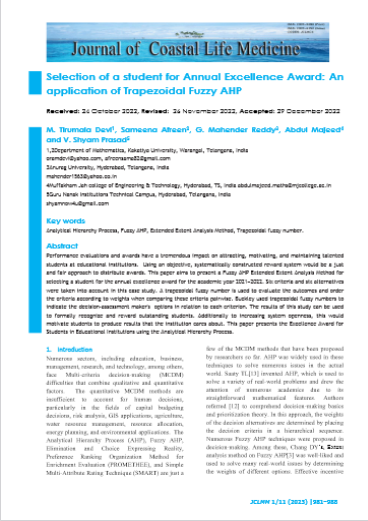Selection of a student for Annual Excellence Award: An application of Trapezoidal Fuzzy AHP
Main Article Content
Abstract
Performance evaluations and awards have a tremendous impact on attracting, motivating, and maintaining talented students at educational institutions. Using an objective, systematically constructed reward system would be a just and fair approach to distribute awards. This paper aims to present a Fuzzy AHP Extended Extent Analysis Method for selecting a student for the annual excellence award for the academic year 2021–2022. Six criteria and six alternatives were taken into account in this case study. A trapezoidal fuzzy number is used to evaluate the outcomes and order the criteria according to weights when comparing these criteria pairwise. Buckley used trapezoidal fuzzy numbers to indicate the decision-assessment maker's options in relation to each criterion. The results of this study can be used to formally recognize and reward outstanding students. Additionally to increasing system openness, this would motivate students to produce results that the institution cares about. This paper presents the Excellence Award for Students in Educational Institutions using the Analytical Hierarchy Process.
Article Details
References
Abhinav Bansal, Trapezoidal Fuzzy Numbers (a, b, c, d): Arithmetic Behavior, International Journal of Physical and Mathematical Sciences. 2011; (2): 39-44.
Ajlouni WME, Kaur G, Alomari SA, Effective Organizational Justice and Organizational Citizenship Behavior Using Fuzzy Logic to Obtain the Optimal Relationship, Quality Management in Healthcare. 2021; 30(1): 13-20.
Chang DY, Applications of the extent analysis method on fuzzy AHP, European Journal of Operational Research. 1996; 95(3): 649-655.
Dubois D, Prade H, The use of Fuzzy Numbers in Decision Analysis, Fuzzy information and Decision Process. 1982: 309-321.
Ismail A, Ridwan M, Abd Razak, Performance-based reward administration as an antecedent of job satisfaction: A case study of Malaysia’s fire and rescue agencies, Geografia-Malaysian Journal of Society and Space. 2016; 12(7): 107-118.
Kafabih F, Budiyanto U, Determination of Annual Employee Salary Increase and Best Employee Reward Using the Fuzzy-TOPSIS Method, 8th International Conference on Information and Communication Technology (ICoICT). 2020:1-5.
Kousalya P, Mahender Reddy G, Selection of a student for All Round Excellence Award using fuzzy AHP and TOPSIS methods. 2011; 1(4): 1993-2002.
Kousalya P, Mahender Reddy G, Supraja S, Shyam Prasad V, Analytical Hierarchy Process approach-An application of engineering education, Mathematica Aeterna. 2013; 2(10): 861-878.
Laarhoven PJM, Pedrycz W, A fuzzy extension of Saaty’s priority theory, Fuzzy Sets and Systems. 1983; 11(1-3): 229-241.
Mahender Reddy G, Kousalya P, FAHP approach with Trapezoidal Fuzzy Numbers in Finding Alternatives for Student Absenteeism in Engineering Colleges-A Comparative Study, Global Journal of Pure and Applied Mathematics. 2015; 11(2): 70-75.
Rai A, Ghosh P, Chauhan R, Singh R, Improving in-role and extra-role performances with rewards and recognition: Does engagement mediate the process?, Management Research Review. 2018; 41(9): 902-919.
Saaty TL, Fundamentals of Decision Making and Priority Theory, 2nd Ed., Pittsburgh, PA: RWS Publications. 2000.
Saaty TL, The analytic hierarchy process, Mc Graw-Hill, New York, 1980.
Setiawati T, Ariani ID, Influence of Performance Appraisal Fairness and Job Satisfaction through Commitment on Job Performance, Review of Integrative Business and Economics Research. 2020; 9(3): 133-151.
Wang YM, Elhag TMS, On the normalization of interval and fuzzy weights, Fuzzy sets and systems. 2006; 157(18): 2456–2471.

